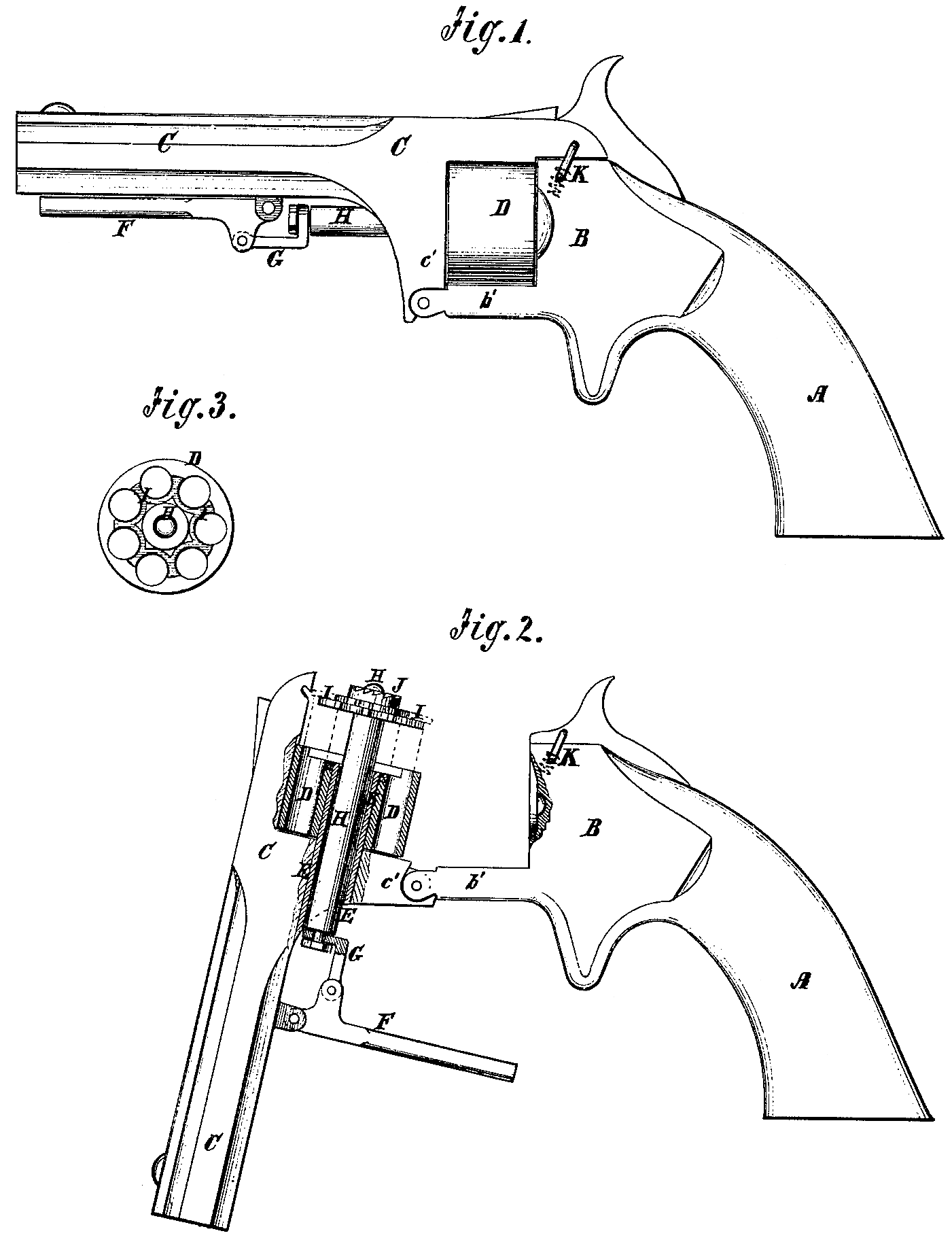US 116559
UNITED STATES PATENT OFFICE.
FREDERIC G. COCHRAN, OF ST. LOUIS, MISSOURI.
IMPROVEMENT IN REVOLVING FIRE-ARMS.
Specification forming part of Letters Patent No. 116,559, dated July 4, 1871.
To all whom it may concern:
Be it known that I, Frederic G. Cochran, of St. Louis, in the county of St. Louis and State of Missouri, have invented a new and useful Improvement in Revolving Fire-Arms; and I do hereby declare that the following is a full, clear, and exact description thereof, which will enable others skilled in the art to make and use the same, reference being had to the accompanying drawing forming part of this specification, in which—
Figure 1 is a side view of a pistol to which my improvement has been attached. Fig.2 is a side view of the same with the barrel thrown up for withdrawing the cartridge-shells and loading, part being broken away to show the construction. Fig. 3 is a rear-end view of the cylinder and retractor.
Similar letters of reference indicate corresponding parts.
My invention has for its object to improve the construction and thereby promote the efficiency of revolving fire-arms, more particularly the class of pistols designed to be carried conveniently ill the pocket and adapted to use fixed ammunition alone. To this end the invention consists in the combination of certain devices for operating the cartridge-ejector, the same being so constructed and arranged as to be reliable in operation; also, strong, durable, not likely to get out of order, easily removed, and adapted to lock or hold the cylinder securely in place or position for firing, as hereinafter fully explained.
In the drawing, A represents the handle or stock; B, the metal breech-block attached there to; and C, the barrel of the weapon. An arm, c’, is formed on the rear end of the barrel, and hinged to the forwardly-projecting arm, b, of the breech-block. The cylinder D is constructed like those ordinarily used for utilizing fixed ammunition, and is arranged to revolve on a tube, E, which fits or is Secured at its front end in the arm c’ of the barrel. The lever F is pivoted to the under side of the barrel, and provided with a hinged angle-link, in whose real end is swiveled a rod, H, that passes through the tube E, and is firmly attached to the ejector-disk I. The rear end of this rod is conical or rounded to adapt it to fit in a recess in the front wall of the breech-block. This recess is clearly shown in section in Fig.2 of drawing. The ratchet-plate J is rigidly attached to the ejector-disk, so that, when acted on in the usual way by the mechanism ordinarily used for the purpose, it effects the rotation of the cylinder by reason of the semicircular notches in the periphery of the disk I fitting against the cartridges; and, since the projecting rims of the cartridges rest on the edges of the said notches, it will be seen that, when the barrel is swung or tilted on its pivot, as shown in Fig. 2, the lever IF can be thrown back, and thus all the cartridges simultaneously ejected. The barrel is held in its normal position for firing by a spring-catch, K, which must be pressed down when it is desired to release the same.
The office of the recess in the breech-block above referred to is to prevent lateral movement of the rear end of the cylinder, and assist to hold it rigidly in exact or proper relation to the barrel when the arm is being discharged.
Having thus described my invention, what I claim as new is—
The lever F, angle-link G, swiveled rod H rounded at its rear end, the ejector-disk I, and recess in the breech-block, combined and arranged as shown and described.
FREDERIC G. COCHRAN
Witnesses:
H. J. COCHRAN,
GEO. J. COCHRAN.

